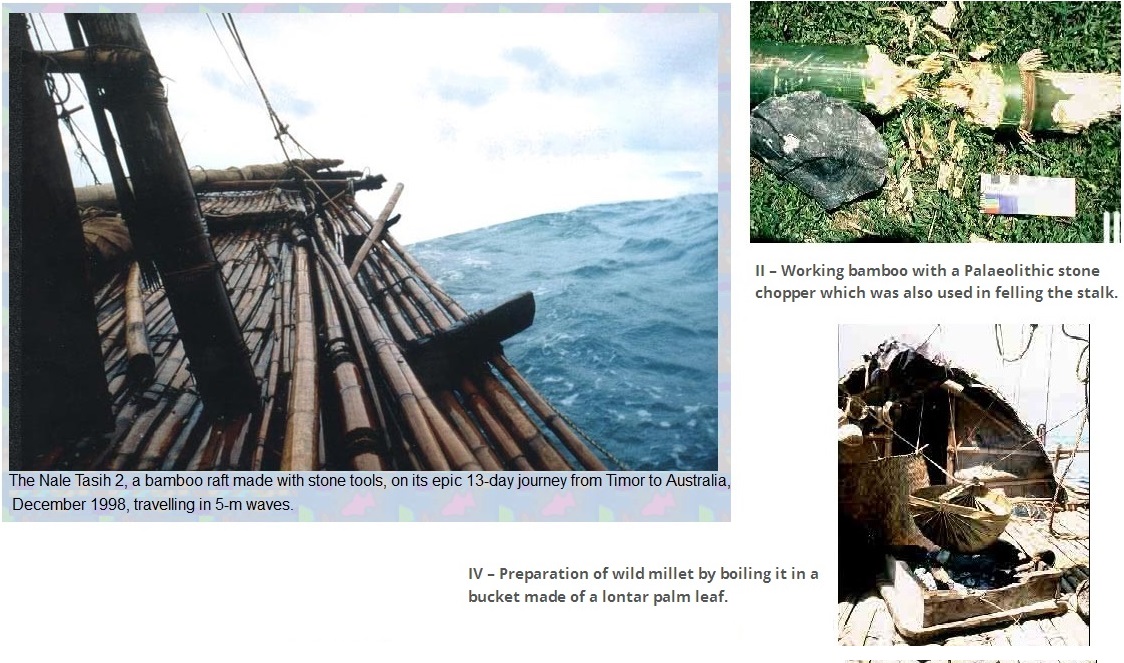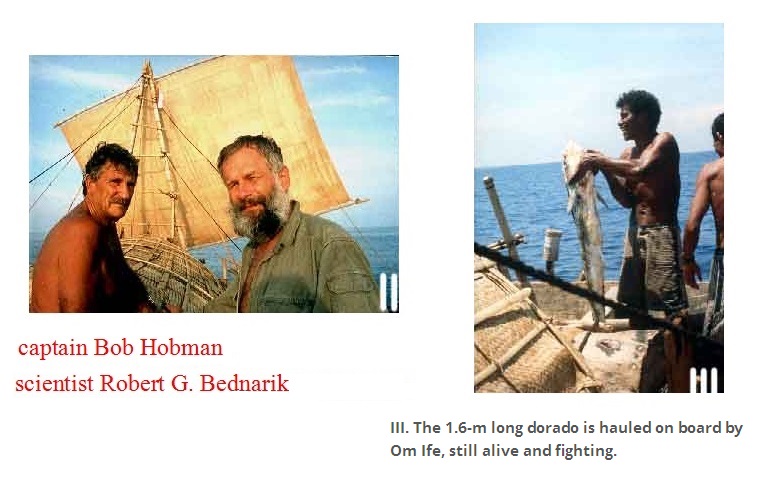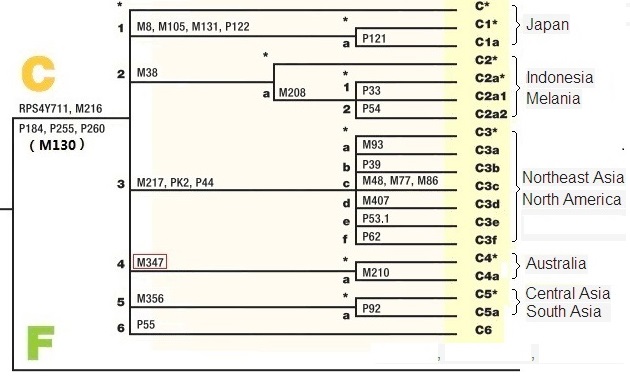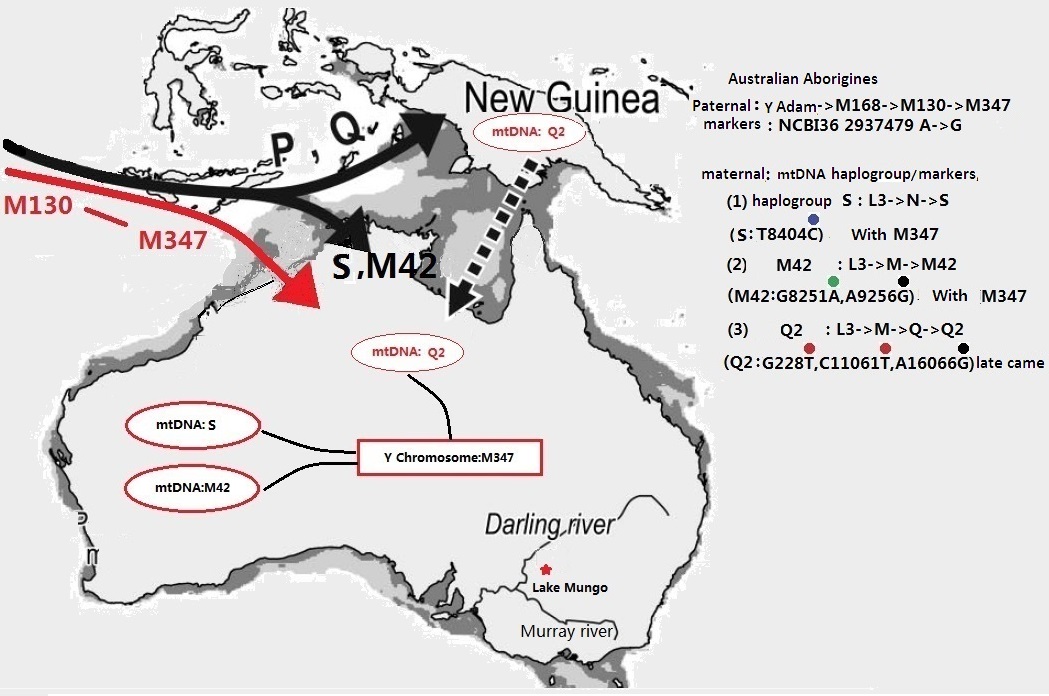|
Back to Homepage
Page 3 of Part 5: A magical trip to Australia
¢¹. A continent without apes
For those scholars interested in the origin of mankind, Australia is a place because it is the only continent with ¡°no indigenous apes§. Even before Europeans landed in Australia in the 17th century, there is no trace that monkeys, apes, or similar primates ever lived there. Only after the Europeans have landed that we found monkeys and apes appear in the zoos. Among all the Australian excavations, there are no skeletal bones from monkeys or apes. On the contrary, there are fossils of aborigines and ancients human beings. Nonetheless, it is impossible to say that they are the products of evolution.
.
According to the theory of continental drift, Australia was separated from the mainland 1.3 hundred million years ago. Even though Australia does not have apes, but it has marsupial animals such kangaroos, wombats, thylacine, and marsupial tiger which constitute the major wildlife there.
.
Moreover, only Australia has platypuses. Although a mammal, it can lay eggs and reproduce. Australia's ancient fossils are very unique such as the fossil of the double incisors beast Diprotodon. When it was alive, its height was 2 meters and weighed three tons. It must have the largest marsupial ever lived on earth. Another one is the marsupial lion fossil. It also is a very unique animal which lived only in Australia.
.
On April 29, 1770, Endeavour with 3 sails of the British Navy reached Kurnell Peninsula at the south west coast of Australia. On August 21, 1770, Captain James Cook officially announced that the entire south west coast of Australia now belonged to the British Empire. He named it New South Wales. However, this pronouncement failed to be acknowledged to by the local people whose response to Captain Cook was by throwing javelin at him. From subsequent investigation, it is estimated that there were 318,000 to 1000,000 people living there and similar to the distribution of present day Australians. Most of they lived along the southwest coast region and the Murray River region.
The Australian aborigines were not backward when compared to ancient's peoples from other continents. They have all kinds of stone tools, javelin, and boats made from tree bark and the worlds only boomerang. About four to five thousand years ago, they also entered the Neolithic Age. They have ax with a wooden handle, harpoon with a fish hook, and javelin with a bag containing dozens of small flint blades made from cut stones. May be because they could not exchange technological information with other ethnic groups, the Australian aborigines nerved entered the Bronze Age. They also failed to produced the bows and arrows commonly used in other regions of the world.
From south to north of Australia, we can find may ancient petroglyphs. The smooth line patterns and vivid characters of human beings and animals all point to a high standard in painting at the time. Using the modern dating methods, archeologists confirmed the coloring used in the petroglyphs at the Arnhem Land Malakunanjo II rock shelter on the western part of Australia dated back to 50,000 years ago (Reference 1). Even though they did not have a written language, but they had orally transmitted myths and stories about their ancestors. There were strict social organization, marriage system and rules in many, many of their tribes. Each tribe had its own territory. They did not lack food. Their bodies were healthy. Before the Europeans landed on Australia, they lived a happy life.
Where did they come from for over 200 years, this question had puzzled archeologists. There were scholars who compared the fossils from the Australian ancient people with the fossils of skull bones from China¡¯s Liuqiang man and found them to be very similar. However, merely resemblance by itself does not prove their relationship like many criminal cases. The most accurate confirmatory method must rely one DNA. Early this century, the earliest research goal of molecular anthropologists was the study of the Australian aborigines. Based on DNA decoding, it was easily confirmed that the Australian aborigines were the descendants of M168 and descendants of a branch of M130. The precise analytical method and crystal clear conclusion of DNA decoding far surpasses other older methods which depend on comparing skeletal bones or evolutionary techniques.
The follow up questions is this: when did they arrive in Australia? DNA decoding is a very accurate method to confirm the human lineage. However, it is not a very accurate method for determining the date. For dating one must rely on confirmation of the dates of bones and stones.
¢¹¢¹. Lake Mungo Man
Mid-2oth century, archeologists discovered three human fossils in Australia's state of New South wales near Lake Mungo. They were named Lake Mungo 1(LM1), Lake Mungo 2 ( LM2) and Lake Mungo 3 ( LM3). LM1 was discovered in 1968 belonging to a female and thus named Mrs. Lake Mungo. LM3 was discovered in 1974 belonging to a male and thus named Mr. Lake Mungo.
.
As to the period of time they had lived, there is difference from different research reports. One of these report using thorium-uranium dating method (230Th/234U) confirmed that LM3 lived around 62,000 plus/minus 6,000 years ago (Reference 2). Mrs Lake Mungo had lived closer to us today. Based on the carbon 14 dating method, she lived between 24,500 to 26,500 years ago.
.
These skeletal bones show that they are ancient modern men. Like us, they have a high, dome forehead. Alan Thorne, a well known archeologist, indicated: The ancient skeletal remains discovered at Lake Mungo belong to a lean tall person. He called them gracile. There is great resemblance in the structure of the skull bones between this gracile man and China's Liujiang Man indicative a special blood relationship between them. The Lake Mungo man may come from south China by way of Indonesia to Australia. (Reference 3)
.
Based on the aforementioned facts, we can deduce that the earliest immigrants to Australia was around 60,000 years ago originating from Asia mainland to Australia via Indonesia.
III.The project of crossing the ocean
If the earliest immigrants arrived in Australia 60,000 years ago, then how did they manage to cross this vast ocean?

Figure 5-16 Crossing the wide ocean 60,000 years ago
First we must answer this question: how far was Australia from Indonesia at that time? From the map above (Figure 5-16), the most likely locations for this crossing is between the island of Timor in Indonesia and Darwin in Australia. There was a period around 60,000 to 65,000 years ago when the sea level was lower by 80 to 100 meter compared to the sea level today. Based on this information one can draw out the travelling distance (Figure 5-16). From this map, one can see that at that time, the travelling distance was much narrower only 150 miles as compared to the 600 miles today. That is to say the ancient modern men had chosen an auspicious time to migrate to Australia.
Pushing the time back 60,000 years, it was not an easy task for our ancestors to cross the vast ocean even though it was only 150 miles. Did they have the capability to do so?
Many attempts were made during the last 20 years by archeologists and marine scientists to find an answer to this question. The most audacious and most risky attempt was made in December, 1998, namely, The First Mariners Project. http://home.vicnet.net.au/~auranet/mariners/web/index.html
This project was completed by Captain Bob Hobman, traditional boat builder, Emmanuel F. Littik, and scientist Robert G. Bednarki, and cameraman Peter Rogers. What is amazing is the fact that from the production of the bamboo raft to the entire crossing was entirely based on the technology and lifestyle at the mid Paleolithic age. They used stone ax to chop the bamboo, bundled bamboo with rattan to form a 18 meter raft. They also used some blades of stone to make the javelin for fishing, cooked meals with wild millet and drilled fire to obtain a fire for cooking (Reference 4).
Relying on these primitive conditions, the five of them started their journey on this raft on December 17, 1998 without an escort boat or radio and left Indonesia's Timor Island port and courageously sailed towards Australia. Overcoming many difficulties and 6 days journey, they finally arrived in Australia. To test the sailing capability of the ancient people, they did not get on land but sailed along the Australia coast for an additional 7 days before they terminated their entire journey. Based on this nearly 1000 miles of sailing project, they firmly believed that the ancient people 60,000 years ago did have the capability to cross the Timor Sea.
When crossing the Timor Sea, how were the ancient people 60,000 years ago differ from them? First, 60,000 years ago, the Timor Sea was only 150 KM wide as compared to 600 KM today. That was definitely an advantage for the ancient people. However, the ancient people did not know where Australia was located. At that time, Australia faced the northern part of Timor Island. Surrounding this was a plain for several hundred miles at sea level less than 100 meter. Even if one stood on the highest peak on Timor Island, one could not have seen the opposite shore. For the ancient people, they embarked on an unchartered journey. It is impossible for us to know what motivation or faith these ancient people had at that time which led them to undertake such a courageous journey.
The ancient people obviously had less scientific knowledge at that time. However, the ancient people were just as smart as Bob Hobman and his colleagues even more so when it came to building the bamboo raft. For 60,000 years, human beings did not undergo evolution. From the viewpoint of evolution, it is possible that 60,000 years ago, the ancient people were still apes. This is a erroneous point of view.
 Figure 5-17 The first sailor who reconstructed the ancient see crossing project Figure 5-17 The first sailor who reconstructed the ancient see crossing project

Figure 5-18 The brave first mariners who reconstructed the crossing
IV. The DNA Decoding Story
The previous analysis just suggests the possibility that the aborigines came from outside of Australia. Just as in some criminal or civil cases, to confirm the certain individual's identity and blood relationship one must ultimately rely on DNA decoding. Likewise, to trace the origins of the Australian aborigines, the answer must come from the molecular anthropologists¡¯ study of the Y chromosome and mitochondrial DNA from these people.
We already know that the paternal genetic database is contained in the Y chromosome and that the maternal genetic database is contained in the mitochondrial DNA. What kind of databases is found in the blood of the Australian aborigines? Let us take a look.
1. Records within the Y chromosome
There are many research reports on the Y chromosome of the Australian aborigines. Most these reports claim that they are descendants of M130 branch just below M168. In the lengthy time period after 60,000 years, in particular the most recent several thousands of years, it is unavoidable to find later immigrants who carry the M89 genetic marker. These later immigrants are descendants of those who left Africa. However, over 65% of the majority of these aborigines, we find the M130 genetic marker. In the previous page, we have introduced those courageous children and grandchildren who first left Africa.
We can speculate the birthplace of the person with the M347 genetic marker might have been the Timor Island. The time of birth was before the crossing the Timor Sea. His scanty descendants reached Australia by a bamboo raft. In subsequent thousands of years, his descendants never went back to Indonesia and thus forming the characteristic Y chromosome genetic marker in the Australian aborigines. Of course, the birth of M347 might have happened after the crossing the Timor Sea. A molecular anthropology research paper was published in 2007 entitled:§ Revealing the prehistoric settlement of Australia by Y chromosome and mtDNA analysis. This article contains interesting reference material which is worth reading for those interested in molecular anthropology ( Reference 5).

Figure 5-19 The paternal Genetic tree of Y chromosome haplogroup M130's descendants
.
2. Mitochondrial DNA marker
.
Our maternal genealogy is recorded in the mitochondrial DNA. From the previous page we learn that the maternal haplogroup L3 accompanied M130's descendants who left Africa. Many generations of daughters after L3 created genetic markers M and N due to subsequent mutations. The grand daughters of M and N (of course the grand daughters of M130) accompanied the grand sons of M130 (of course M and N's grandsons) continued to migrate to far away places (Please refer to Figure 2-11 Maternal Genetic tree in Page 2 of Part2).
.
There are two major mitochondrial haplogroups in Australian aborigines. One is M42 from M and the other is S from N. Both of these haplogroups are only found in Australia. In the aforementioned report concerning mitochondrial DNA estimation, M42 haplogroup was born between 40,000 to 50,000 years ago and S haplogroup between 20,000 to 30,000 years ago. Man with M347 might have married two wife who respectively belongs to the M and N haplogroup. Another possibility is that the children and grandchildren of M347 married wives who came from either the M haplogroup or the N haplogroup. After crossing the Timor Sea, M42 was created from M and S from N due to mutation. We can speculate that only a very small number of people in a family actually crossed the Timor Sea.
.
.
Figure 5-20 Australian Aborigines Y chromosome haplogroups and mitochondrial haplogroups
3. The stolen bride?
After the crossing, M347's family had no contact with immigrants from outside of Australia in the several thousands of years. They were a lonely ethnic group oversea. Therefore, their Y chromosome and mitochondrial DNA constituted one family in Australia. Yet, a very special phenomenon is that in both the Australian aborigines and the New Guinea aborigines the Q2 haplogroup genetic marker was simultaneously found. What had happened? In the aforementioned report (Reference 5), it was pointed out that Q2 was born about 30,400 years ago. The birth place was New Guinea. There once was a land bridge between New Guinea and Australia which was damaged by gradually rising sea water about 8,000 years ago.
.
Therefore, it is likely that during certain time 8,000 years ago Q2 floated towards Australia.
.
What needs to be emphasized is the fact that Q2 was found in Australia in some individuals£¬ but the Y chromosome M347 and mitochondrial M42 and S are not finding in New Guinea.
.
What this means is that New Guinea women with the mitochondrial Q2 walked across the land bridge from New Guinea to Australia and yet there were no Australian men or women who went to New Guinea. Does this mean that these New Guinea women were stolen brides? We will leave our wise readers to judge.
.
4. DNA decoding depicts the three dimensional graphics of history of mankind
The decoding of Australian aborigines DNA reveals a story which could not have been uncovered otherwise with any other archeological research method. This is why DNA decoding is so unique in anthropological research. From the Y chromosome genetic marker M347's location on the paternal genetic tree we can see that Australian aborigines were descendants of M130. From this we can depict the migratory route of their ancestors from Africa to Australia. We can find out the close relationship between people in Australia and those from Indonesia, India and Africa. We could establish the distribution map around the world by connect the M130 branches and the M130 from Asia and Americas simultaneously on this same map (Please see the front cover of this book). Likewise, we can also establish the maternal genetic tree L3 haplogroup with M and N distribution.
Searching upward in time beginning with the Australian with the paternalM137 genetic marker we could find the persons with the M168 genetic marker who lived 90,000 years ago. Moving even further upward, we could trace it back to Y chromosome Adam (Please see Figure 2-5 mankind¡¯s paternal genetic tree). Likewise if we searching upward in time beginning with the Australian with the female genetic markers M42 and S, we could find M and N 70,000 years ago and then L3 until mitochondrial Eve. (Please see Figure 2-11 The Mitochondrial lineage tree in Page 2 of Part 2 ).
For all these we can see that DNA decoding can indeed depict an accurate, three-dimensional graphics of the origin of mankind and the history of migration.
Reference:
1. M. H. Monroe,Australia: The Land Where Time Began,2013.
2. Thorne A, et. al.,Australia's oldest human remains: age of the Lake Mungo 3 skeleton. J Hum Evol. 1999 Jun;36(6):591-612.
3. Colin Groves, Alan Gordon Thorne 1939¨C2012, Paleo Anthropology 2013: 28−32.
4.The First Mariners Project: http://home.vicnet.net.au/~auranet/mariners/web/index.html
5. Georgi Hudjashova,et. al. ,Revealing the prehistoric settlement of Australia by Y chromosome and mtDNA analysis,PNAS , May 22 2007.
|